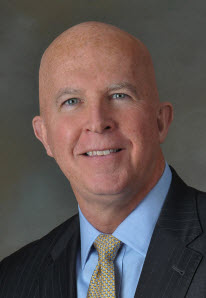The ASIS New York City Chapter is pleased to announce it’s “Person of the Year”!
 Join us on Thursday, June 8, 2017, from 12:00 – 2:00 pm to honor this outstanding public servant, James P. O’Neill, at the Person of the Year Luncheon. James P. O’Neill, New York Police Commissioner, will be recognized as the ASIS NYC Chapter “2017 Person of the Year” for his dedication to the men and women in the law enforcement, security industries, and his commitment to providing for a safe and secure nation. Tickets for the Person of the Year Luncheon can be purchased at $75 each or $750 per table of ten HERE.
Join us on Thursday, June 8, 2017, from 12:00 – 2:00 pm to honor this outstanding public servant, James P. O’Neill, at the Person of the Year Luncheon. James P. O’Neill, New York Police Commissioner, will be recognized as the ASIS NYC Chapter “2017 Person of the Year” for his dedication to the men and women in the law enforcement, security industries, and his commitment to providing for a safe and secure nation. Tickets for the Person of the Year Luncheon can be purchased at $75 each or $750 per table of ten HERE.
James P. O’Neill New York Police Commissioner
James P. O’Neill was appointed the 43rd police commissioner of the City of New York by Mayor Bill de Blasio in September 2016. He had served previously as chief of department, the NYPD’s highest uniformed rank. He was instrumental in developing the neighborhood-based policing model that is renewing and recasting the NYPD’s patrol function to provide greater police and community interaction and collaboration.
Widely experienced in both the patrol and the investigative sides of the department, Commissioner O’Neill is a hands-on police practitioner and a dedicated police reformer. He speaks with urgency about “the need for police to evolve” if they are to succeed in connecting with communities and keeping people safe in the 21st Century.
Police Commissioner O’Neill began his law-enforcement career in 1983 with the Transit Police, which was then an independent police department. He credits his time on patrol on the trains and platforms of the subway system with helping him learn how to interact and communicate with a wide range of people, a skill he regards as essential to successful police work. He had risen to lieutenant by the time of the 1995 merger of the Transit Police with the NYPD.
As a lieutenant in the NYPD, he worked at the police academy and the warrant squad before promoting to captain and a post as the executive officer in the 52nd Precinct in the northern Bronx. He served as the commanding officer of three successive precincts: Central Park, the 25th Precinct in eastern Harlem, and the 44th Precinct in the western Bronx. He was C.O. of the 25th Precinct when the September 11th attack occurred and remembers being so proud of the way his fellow officers from all across the department came together to help and protect people during that crisis.
It was as C.O. of the 44th Precinct, one of the busier commands in the city, that Commissioner O’Neill began to think seriously about reforming the NYPD patrol model. The precinct workload in the NYPD had long been divided between patrol officers who answered a steady stream of calls for service, and specialty officers who worked at correcting conditions and community outreach. As Commissioner O’Neill saw it, police departments had been asking their patrol officers to connect with community members for generations without ever giving them the time or the opportunity to do so. He envisioned a model with fewer specialists and more generalist officers, who answered calls, worked at problem-solving and local crime-fighting, and collaborated far more effectively with community members.
Promoting to inspector and then to deputy chief, Commissioner O’Neill moved to the investigative side of the department, serving tours as commanding officer of the Vice Division, the Narcotics Division, and the Fugitive Enforcement Division. He worked in all three capacities to keep cases focused on reducing crime and supporting the priorities of precinct commanders.
In March 2014, he was appointed commanding officer of Police Commissioner William Bratton’s office and played a key role in the department’s reengineering process, concentrating on operational reforms. As chief of patrol from June 2014, he began the development of the Neighborhood Coordination Officer plan, anchoring officers in sectors and providing them with off-radio time to connect with community members and work at local problem-solving and crime-fighting.
Appointed Chief of Department in December 2014, he was almost immediately confronted with widespread protests related to the death of Eric Garner during an arrest the prior June. The NYPD’s handling of these protests was deemed a model of restraint and professionalism by observers in the city and all across the country. Also early in his term, he helped lead the department through the shock and mourning that followed the assassinations of Detectives Rafael Ramos and WenJian Liu.
The neighborhood-based policing model – which is a crime-fighting plan above all else – will be in place in half of New York City precincts and all of the NYPD Housing Bureau police service areas by this coming October, serving more than three million New Yorkers. It is the largest, best-funded, best-staffed community-policing initiative ever undertaken in the United States. Commissioner O’Neill’s reforms are taking hold and will have a far-reaching and positive influence all across New York City.
Commissioner O’Neill grew up in the Flatbush section of Brooklyn and was one of seven children. He has two sons himself, Daniel and Christopher. He is an avid hockey player and motorcyclist.
Commissioner O’Neill has a clear vision of where he is taking the New York City Police Department.
“Fighting crime is what we get paid to do,” he says. “But we can’t do that unless we achieve full partnership with the community. Unless we have that connectivity, it’s not going to work.”

